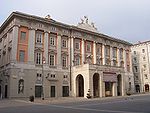Museo Sartorio

The Civico Museo Sartorio is a museum in Trieste, northern Italy. Set in an urban villa, it exhibits ceramics, majolica, porcelain and pictures, typical equipment of Trieste's villas at the end of the 19th century.Besides the villa itself being a very interesting building architecturally, it contains drawings of Giambattista Tiepolo, painting of Giambattista Pittoni and a glyptotheque. The museum opened to the public partially in 1949 and completely 1954. In 2006, the museum reopened after a period of renovation. Currently the Museum hosts temporary exhibits and cultural events such as theatre and music in the summer.
Excerpt from the Wikipedia article Museo Sartorio (License: CC BY-SA 3.0, Authors, Images).Museo Sartorio
Largo Papa Giovanni Ventitreesimo, Trieste Città Nuova-Barriera Nuova-San Vito-Città Vecchia
Geographical coordinates (GPS) Address Website External links Nearby Places Show on map
Geographical coordinates (GPS)
| Latitude | Longitude |
|---|---|
| N 45.646111111111 ° | E 13.763333333333 ° |
Address
Civico Museo Sartorio
Largo Papa Giovanni Ventitreesimo 1
34123 Trieste, Città Nuova-Barriera Nuova-San Vito-Città Vecchia
Friuli-Venezia Giulia, Italy
Open on Google Maps










